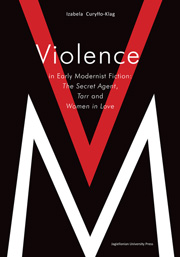Book contents
- Frontmatter
- Contents
- Acknowledgements
- Introduction
- CHAPTER I Modernist Consciousness of Crisis and the Emergent Violence Mythos
- CHAPTER II Ticking Towards Disaster—Violence as “The Enemy Within” in Conrad's The Secret Agent
- CHAPTER III “All Personality Was Catching”—Mimetic Rivalry and the Contagion of Violence in Tarr
- CHAPTER IV Humanity in a Cul-de-sac: Women in Love as an Epic of Sacrificial Crisis
- Conclusion
- Bibliography
- Frontmatter
- Contents
- Acknowledgements
- Introduction
- CHAPTER I Modernist Consciousness of Crisis and the Emergent Violence Mythos
- CHAPTER II Ticking Towards Disaster—Violence as “The Enemy Within” in Conrad's The Secret Agent
- CHAPTER III “All Personality Was Catching”—Mimetic Rivalry and the Contagion of Violence in Tarr
- CHAPTER IV Humanity in a Cul-de-sac: Women in Love as an Epic of Sacrificial Crisis
- Conclusion
- Bibliography
Summary
One of the ways of approaching early modernist fiction is to view it as a record of catastrophic imagination. Shaped by the circumstances of its time—the excessive pace of civilisational advancement, ideological and ethical turmoil, the rise of militarism—it envisions dystopian scenarios and warns against a pandemonium that at any moment can ensue from the faltering system. A tremor runs through many modernist creations, investing them with “a sense of disorientation and nightmare” which, according to Bradbury and McFarlane's standard definition, constitutes the hallmark of the epoch. Connected to this perpetual state of emergency is a constant anticipation of a violent breakthrough—some sudden, spasmodic occurrence that will radically put an end to what has deteriorated beyond repair. The forms of imagined violence are muliple, ranging from aberrant individual reversals to barbarity, threats of terrorism and foreign invasions, down to a universal collapse into the shambles of slaughter, or—perhaps more humane—a neat and quick self-annihilation by means of a perfect explosive.
In bringing together three important texts of British modernism, this book takes a closer look at such imaginings, and attempts to investigate them in the light of selected aspects of anthropological theory. It also takes into account the social and historical context in which they are grounded, for one of the premises of this study is the idea that literature is a reflection of a cultural moment.
- Type
- Chapter
- Information
- Violence in Early Modernist FictionThe Secret Agent, Tarr and Women in Love, pp. 9 - 11Publisher: Jagiellonian University PressPrint publication year: 2011



